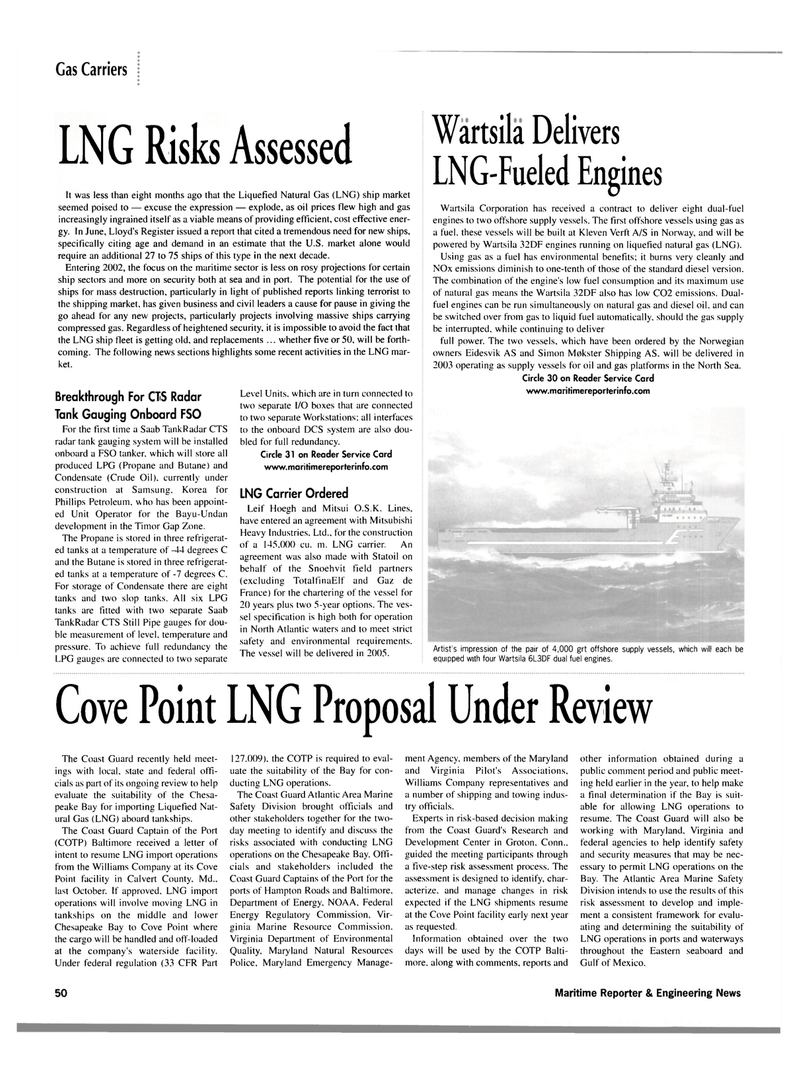
Page 53: of Maritime Reporter Magazine (January 2002)
Read this page in Pdf, Flash or Html5 edition of January 2002 Maritime Reporter Magazine
Gas Carriers
LNG Risks Assessed
It was less than eight months ago that the Liquefied Natural Gas (LNG) ship market seemed poised to — excuse the expression — explode, as oil prices flew high and gas increasingly ingrained itself as a viable means of providing efficient, cost effective ener- gy. In June, Lloyd's Register issued a report that cited a tremendous need for new ships, specifically citing age and demand in an estimate that the U.S. market alone would require an additional 27 to 75 ships of this type in the next decade.
Entering 2002, the focus on the maritime sector is less on rosy projections for certain ship sectors and more on security both at sea and in port. The potential for the use of ships for mass destruction, particularly in light of published reports linking terrorist to the shipping market, has given business and civil leaders a cause for pause in giving the go ahead for any new projects, particularly projects involving massive ships carrying compressed gas. Regardless of heightened security, it is impossible to avoid the fact that the LNG ship fleet is getting old. and replacements ... whether five or 50. will be forth- coming. The following news sections highlights some recent activities in the LNG mar- ket.
Breakthrough For CTS Radar
Tank Gauging Onboard FSO
For the first time a Saab TankRadar CTS radar tank gauging system will be installed onboard a FSO tanker, which will store all produced LPG (Propane and Butane) and
Condensate (Crude Oil), currently under construction at Samsung, Korea for
Phillips Petroleum, who has been appoint- ed Unit Operator for the Bayu-Undan development in the Timor Gap Zone.
The Propane is stored in three refrigerat- ed tanks at a temperature of -44 degrees C and the Butane is stored in three refrigerat- ed tanks at a temperature of -7 degrees C.
For storage of Condensate there are eight tanks and two slop tanks. All six LPG tanks are fitted with two separate Saab
TankRadar CTS Still Pipe gauges for dou- ble measurement of level, temperature and pressure. To achieve full redundancy the
LPG gauges are connected to two separate
Level Units, which are in turn connected to two separate I/O boxes that are connected to two separate Workstations: all interfaces to the onboard DCS system are also dou- bled for full redundancy.
Circle 31 on Reader Service Card www.maritimereporterinfo.com
LNG Carrier Ordered
Leif Hoegh and Mitsui O.S.K. Lines, have entered an agreement with Mitsubishi
Heavy Industries. Ltd., for the construction of a 145.000 cu. m. LNG carrier. An agreement was also made with Statoil on behalf of the Snoehvit field partners (excluding TotalfinaElf and Gaz de
France) for the chartering of the vessel for 20 years plus two 5-year options. The ves- sel specification is high both for operation in North Atlantic waters and to meet strict safety and environmental requirements.
The vessel will be delivered in 2005.
Wartsila Delivers
LNG-Fueled Engines
Wartsila Corporation has received a contract to deliver eight dual-fuel engines to two offshore supply vessels. The first offshore vessels using gas as a fuel, these vessels will be built at Kleven Verft A/S in Norway, and will be powered by Wartsila 32DF engines running on liquefied natural gas (LNG).
Using gas as a fuel has environmental benefits; it burns very cleanly and
NOx emissions diminish to one-tenth of those of the standard diesel version.
The combination of the engine's low fuel consumption and its maximum use of natural gas means the Wartsila 32DF also has low C02 emissions. Dual- fuel engines can be run simultaneously on natural gas and diesel oil, and can be switched over from gas to liquid fuel automatically, should the gas supply be interrupted, while continuing to deliver full power. The two vessels, which have been ordered by the Norwegian owners Eidesvik AS and Simon M0kster Shipping AS, will be delivered in 2003 operating as supply vessels for oil and gas platforms in the North Sea.
Circle 30 on Reader Service Card www.maritimereporterinfo.com
Artist's impression of the pair of 4,000 grt offshore supply vessels, which will each be equipped with four Wartsila 6L3DF dual fuel engines.
Cove Point LNG Proposal Under Review
The Coast Guard recently held meet- ings with local, state and federal offi- cials as part of its ongoing review to help evaluate the suitability of the Chesa- peake Bay for importing Liquefied Nat- ural Gas (LNG) aboard tankships.
The Coast Guard Captain of the Port (COTP) Baltimore received a letter of intent to resume LNG import operations from the Williams Company at its Cove
Point facility in Calvert County. Md.. last October. If approved, LNG import operations will involve moving LNG in tankships on the middle and lower
Chesapeake Bay to Cove Point where the cargo will be handled and off-loaded at the company's waterside facility.
Under federal regulation (33 CFR Part 127.009). the COTP is required to eval- uate the suitability of the Bay for con- ducting LNG operations.
The Coast Guard Atlantic Area Marine
Safety Division brought officials and other stakeholders together for the two- day meeting to identify and discuss the risks associated with conducting LNG operations on the Chesapeake Bay. Offi- cials and stakeholders included the
Coast Guard Captains of the Port for the ports of Hampton Roads and Baltimore,
Department of Energy, NOAA, Federal
Energy Regulatory Commission, Vir- ginia Marine Resource Commission.
Virginia Department of Environmental
Quality, Maryland Natural Resources
Police. Maryland Emergency Manage- ment Agency, members of the Maryland and Virginia Pilot's Associations,
Williams Company representatives and a number of shipping and towing indus- try officials.
Experts in risk-based decision making from the Coast Guard's Research and
Development Center in Groton. Conn., guided the meeting participants through a five-step risk assessment process. The assessment is designed to identify, char- acterize, and manage changes in risk expected if the LNG shipments resume at the Cove Point facility early next year as requested.
Information obtained over the two days will be used by the COTP Balti- more, along with comments, reports and other information obtained during a public comment period and public meet- ing held earlier in the year, to help make a final determination if the Bay is suit- able for allowing LNG operations to resume. The Coast Guard will also be working with Maryland, Virginia and federal agencies to help identify safety and security measures that may be nec- essary to permit LNG operations on the
Bay. The Atlantic Area Marine Safety
Division intends to use the results of this risk assessment to develop and imple- ment a consistent framework for evalu- ating and determining the suitability of
LNG operations in ports and waterways throughout the Eastern seaboard and
Gulf of Mexico. 50 Maritime Reporter & Engineering News

 52
52

 54
54
